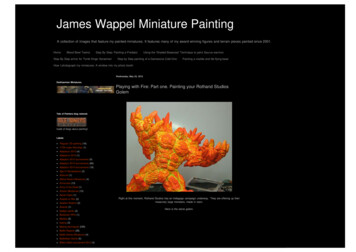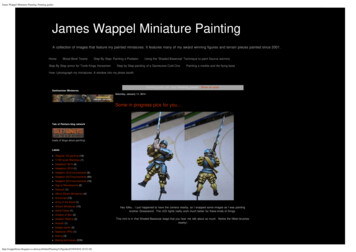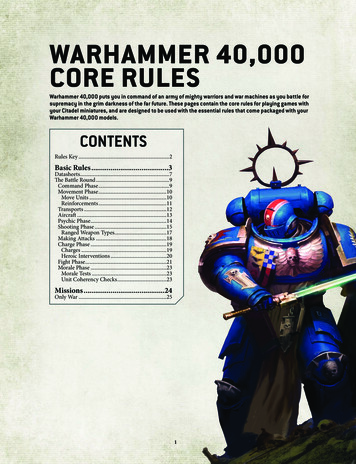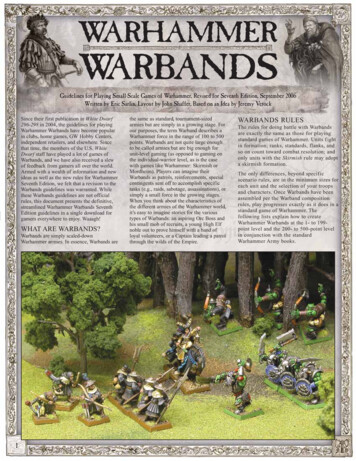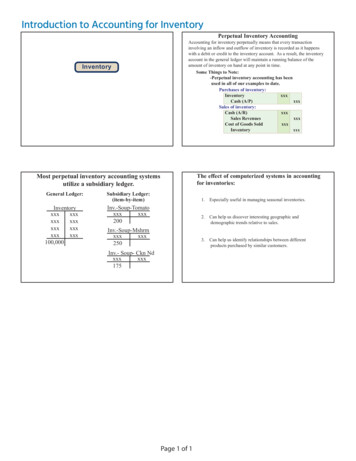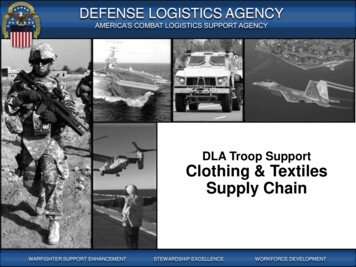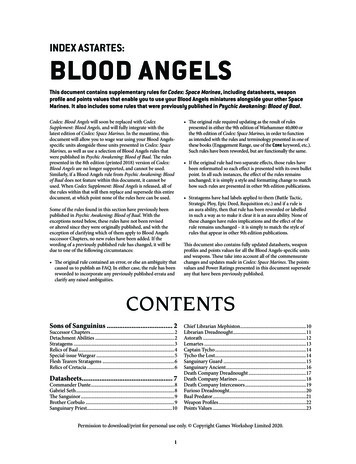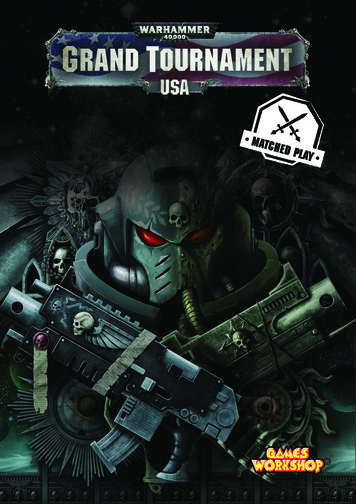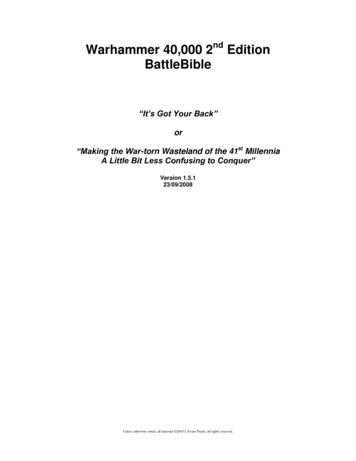
Transcription
Warhammer 40,000 2nd EditionBattleBible“It’s Got Your Back”or“Making the War-torn Wasteland of the 41st MillenniaA Little Bit Less Confusing to Conquer”Version 1.5.123/09/2008Unless otherwise noted, all material 2010 J. Evans Payne, all rights reserved.
Table of ContentsIntroduction . 4USING THE BATTLEBIBLE .5A GAME OF WARHAMMER 40,000 .7GENERAL RULES . 10WEAPON RULES . 20Phases of a Game Turn . 22MOVEMENT PHASE . 23SHOOTING PHASE . 28HAND-TO-HAND COMBAT PHASE . 32PSYCHIC PHASE . 36RALLY PHASE . 46PSYCHOLOGY. 47Armies of the 41st Millennium . 49CHAOSRules . 50Wargear. 53Chaos Space Marine Rules. 58Chaos Space Marine Equipment . 59Chaos Space Marine Units . 62Chaos Cult Equipment. 69Chaos Cult Units . 72Chaos Daemon World Units . 74ELDARRules . 77Equipment . 79Units . 81IMPERIAL AGENTSEquipment . 93Units . 96Adeptus Mechanicus . 96Imperial Inquisition . 97IMPERIAL ADEPTUS ARBITESEquipment . 99Units . 101IMPERIAL ASSASSINSIMPERIAL GUARDRules . 105Equipment . 107Units . 109NECRONSRules . 120Units . 121ORKSRules . 123Equipment . 125Units . 127SISTERS OF BATTLERules . 138Equipment . 139Units . 1421
SPACE MARINESRules . 148Equipment . 149Units . 152Blood Angel Units . 163Dark Angel Rules . 165Dark Angel Units . 166Legion of the Damned Rules . 170Legion of the Damned Equipment . 171Legion of the Damned Units . 173Space Wolves Rules . 176Space Wolves Units . 177Ultramarines Units . 182SQUATSRules and Equipment . 184Units . 186TYRANIDSTyranid Rules . 190Tyranid Units. 195Genestealer Cult Equipment . 199Genestealer Cult Units . 201Wargear . 204WARGEAR CARDS . 205WEAPONSBasic Weapons . 224Close Combat Weapons. 230Heavy Weapons . 233Pistols . 240Support Weapons. 242Wargear Weapons . 248Shooting. 254Grenades . 256Special . 256Ammo Types . 256VEHICLE MODIFICATIONSVehicle Options for All Armies . 260Modifications for Chaos Space Marines . 261Modifications for Eldar . 262Modifications for Orks . 262Modifications for the Imperium . 263Weapon Conversion . 264Warhammer 40K FAQ . 264Firing. 264Close Combat . 266Psionics . 266Armour . 267Space Marines . 267Space Wolves Codex . 267Angels of Death Codex . 268Chaos Codex . 269Eldar Codex . 270Orks Codex . 270Vehicles . 271Wargear. 2712
APPENDIX A: OPTIONAL TYRANID ADDITIONS . ERROR! BOOKMARK NOT DEFINED.APPENDIX B: OPTIONAL WEAPON RULES . ERROR! BOOKMARK NOT DEFINED.APPENDIX C: OPTIONAL WEAPONS . ERROR! BOOKMARK NOT DEFINED.APPENDIX D: OPTIONAL WARGEAR CARDS. ERROR! BOOKMARK NOT DEFINED.APPENDIX E: VEHICLE MODIFICATIONS . ERROR! BOOKMARK NOT DEFINED.APPENDIX Z: UNSORTED RULES . ERROR! BOOKMARK NOT DEFINED.BATTLEBIBLE FAQ . ERROR! BOOKMARK NOT DEFINED.3
Introduction4
Using the BattleBibleUsing the BattleBiblePurposeThe second edition of Warhammer 40,000 is an exciting, beautiful game — but it often seems to sacrifice simplicityto gain challenge. With three main rulebooks, a dozen templates, dozens of dice, and some nine Codexes, it‘s oftendifficult to find the rule you‘re looking for. The lack of an index in any of these books complicates things, and thescarcity of cross-references makes for tedious searches.That‘s why the BattleBible was created. It attempts to simplify things as much as possible, so you can focus on theaspects of the hobby that were meant to be the challenging aspects — painting, strategy, and scraping togetherenough cash for that new Dreadnought.The text in this document is not a straight copying of that of the original — indeed, very little of the rules‘ originalwording has survived. This is an intentional decision and was made chiefly because of copyright infringement lawsand secondly because the grammar of the original books is sometimes vague and in error. Where deemed necessary,clarifications have been made, and all attempts have been made to make sure that any additional rules orassumptions are valid and coincide with the intent of the original rules.ConventionsAt first glance, the BattleBible may appear to be cluttered with confusing notations. Many of these are actuallyattempts to make things easier on the war gamer. As is often the case with features that attempt to empower, thesenotations require some explanation, and may take some getting used to.HyperlinksSometimes, the text of a rule or description of a unit will make a reference to another rule, unit or otherdescription. In most of these cases, the word or words that refer elsewhere are underlined, and appear as ahyperlink. Simply click on the hyperlink and you‘ll soon be looking at the reference. Here‘s an example of ahyperlink in the text of a rule:Once inside a building, models may only move at their normal rate, and may not run (24).As you can see, the word ―run‖ is underlined and coloured blue. If you are perusing the BattleBible usingMicrosoft Word, and click on the word ―run‖ (or if you flip to page 24, if you‘re looking at a hard-copy), youwill be taken to the rules for running, as seen here:Rule — MovementRunningA whole squad runs together. Running models double their normal move, but cannot fire inthe shooting phase. Troops may only run if there is no enemy within 8” of them.Cross-ReferencesAlas, the underlined hyperlink is seldom helpful if you‘re looking at a hard-copy printout of the BattleBible. Tocompensate for this, the BattleBible also has cross-references, which appear as numbers in parentheses to theright of any hyperlink. The number is the page number of the reference, and this number is updated every timeyou print the BattleBible out. Any reference that has a hyperlink will also have a cross-reference. In the aboveexample of the referenced rule for Running, the cross reference ―(28)‖ means that the rule for running is locatedon Page 28. In some cases, such as where the reference itself has some information in parentheses, it might get alittle confusing, but remember that the first number — the one closest to the reference — contains the pagenumber of the reference‘s target. The most common example might be the Wargear Card ―Targeter‖, whichgives the model wearing it a 1 bonus for hitting targets with ranged weaponry. Other examples are commonitems whose effects can be summarized in an inch-long parenthetical overview. Without the cross-reference, amentioning of the Targeter might look like this:This model comes with a Targeter ( 1 to hit) and a really nifty paint job.5
Using the BattleBibleBut with the reference, it looks like this:This model comes with a Targeter (221, 1 to hit) and a really nifty paint job.Note that the ―221‖ that comes first in the parenthesis means that more detailed information about the Targeter canbe found on that page, and has nothing to do with the ― 1‖.EDIT: It‘s been ten years since the final version, 1.3.7, was released. I‘ve decided to update this fellow‘s work asbest as I can, sticking as close as possible to his chosen format. Here‘s what‘s new:-Legion of the Damned entry edited to follow their final 2 nd ed ruleset from WD 224Sisters of Battle entry completed, and numerous errors fixed in the material that was thereOrk special characters addedMusket, Handbow added to Weapons sectionSoB Relics added to the Wargear and Weapons sectionsChaos Post-Heresy Terminators reduced to 5 pts over Loyalist ones, rather than 1.3.7‘s listing of 10 ( 5 iswhat my Chaos codex says it costs – am I missing something?)Necromunda and homebrewed codexes removed to save space and make this strictly a legal 40K document(though I‘m not sure which of the optional rules at the end are fan-submitted)Added a trimmed version of an old FAQ concerning the BattleBible, put out at the end of its run by the originalauthor, for strictly historical interestSome reorganization to make it a bit easier to follow (things reordered, table of contents trimmed so that it‘snot 700 pages long, all Space Marines grouped together, etc)Random typo fixesUpdated to MS Word 20031.5.1 Update: Some minor reorganizations and typo fixes; corrected page numbers; added Ork dreadnought.Hopefully that‘s it.99.99% of the work found here had nothing to do with me: all credit goes to Jason Payne and his helpers circa 1998.6
A Game of Warhammer 40,000A Game of Warhammer 40,000Fifteen StepsAt its most basic level, a game of Warhammer 40,000 involves following fifteen steps. Some of these steps are morecomplex than others, and many steps involve sub-steps which are covered in greater depth later in the Bible. Thissection is for a general overview of the game or for newbies who have never played.1: Agree on PointsThe Point System of Army ConstructionA game of any kind is fun only if the participants are balanced — that is, if neither side has an obvious advantagefrom the start. In an attempt to ensure the fairness of Warhammer 40,000, the Points system is used. Each option —tank, individual model, squad, weapon or piece of equipment — that you can have has an associated Point Cost. Thegreater the number of Points a certain option costs, the more powerful an influence it is likely to produce — a tank,for example, costs much more than your average lightly-armoured grunt. The Points Cost of any option is generallylisted with the option‘s description — the Army Lists are the most common places to find Points Costs.With certain rare exceptions, each model you place on the battlefield costs you Points to have in your army. Manymodels are capable of carrying weapons and other equipment that they don‘t come equipped with normally — theseoptions are obtained at further Point Cost. This method of ―buying‖ options provides a control system for fairnessand flexibility — two players could spend the same amount of Points on the same Army Lists and produce verydifferent armies.If you make add-on rules or units for your armies, make sure to carefully consider their impact on the game whendeciding how many Points they are to be worth. As a common courtesy, you must make sure you have other players‘approval before fielding any customizations to the army list.The very first step of a game of Warhammer 40,000 is for all players to agree on how many points each will spend.This can be any number, although commonly a multiple of 500 (1000, 1500, etc.). The Army Lists and thelimitations (e.g., at least 25% squads) therein have been built with a 500-1500 point force in mind as the smallest. Inone-on-one battles (the most common), each player will get to spend the same amount points on his/her army.Obviously, if you have a 2-on-1 battle, the side with the lone player should get twice as many points as either of theother players to spend on his army.2: Build Armies Using PointsEach player ―buys‖ her army by making selections from the Army Lists. Unless you and your opponent agreeotherwise, you must make all selections from a single Army List of your choosing. Note, however, that the ―Allies‖section of each Army List allows you to make restricted selections from other Army Lists. You are also subject toother restrictions specific to each Army List when building your armies; these restrictions are noted under eachArmy List‘s description.3: TerraformingDuring this step, all players construct what will be the battlefield for the game. Another term for it is ―placingterrain‖, though ―terraforming‖ sounds more impressive. There are two schools of thought regarding terraforming.Some players prefer to work together to build a setting that follows a certain theme or flavour that all agree on (forexample, the conquest of a desert world or the raiding of a supply bunker). Other prefer to take turns placing terrainso that neither table edge will contain a particular tactical advantage due to landscape. How much terrain is placed,and how much of the battleboard is covered with some kind of terrain is totally up to the players involved. Thegeneral consensus, however, seems to be that the more terrain, the better the game — from an aesthetics point ofview as well as a playability perspective.7
A Game of Warhammer 40,0004: Mark Deployment ZonesThere are two Deployment Zones (these are the areas inside which your models will be placed to start the game),one on each of the long sides of the standard 4‘ x 6‘ rectangular gaming board. The zones begin at the long tableedges and extend into the board 12”. There is a margin of 12” on each side.Take four counters and place them where the X‘s are to denote where the two Deployment Zones end.5: Draw Mission Cards (optional)To make the game a little more realistic, if both sides agree, each player may draw a Mission Card at random. Theseare cards which define specific goals of each force, and describe the rewards which accompany theiraccomplishment. Mission Cards (15) are described later.As an alternative to Mission Cards, feel free to define your own custom objectives — ―destroy that building‖, or―defend that group of civilians". As with any customizations of the game, anything goes — so long as youropponents agree on it.6: Draw Strategy Cards (optional)All players but those who command Tyranid forces may draw Strategy Cards (17). You may draw one Strategy Cardat random for each 1,000 points or multiple thereof that your army consists of — for example, the commander of a1,250-point army would draw 2 cards, and the commander of a 2,980-point army would draw 3 cards. For each card,you are allowed a ―mulligan‖ — that is, you may replace the card drawn and redraw. You must, however, keep theredrawn card even if it is less desirable than the original.7: Determine Deployment ZonesThe side with the highest Army Strategy Rating gets to select which Deployment Zone they want, with ties beingrandomized. Alternately, the player who did not set up the battleboard may select their desired side. Since thisshould not make a large tactical difference (because neither side should be favoured with advantage-granting terrainfeatures), feel free to use whatever methods you want to determine it.8: Determine Troop Setup OrderEach army gets a base Strategy Rating as follows:Race/ArmySpace MarinesEldarOrks or ChaosImperial Guard or SquatsTyranidsArmy Strategy Rating54321Whoever has the smallest Strategy Rating must deploy his troops first; settle ties with D6 randomization.9: Troop DeploymentEach player may place the models he has purchased using Points wherever he wants within his Deployment Zone.However, all squads must begin the game within Squad Coherency (12) distance to each other, and all vehicles mustbegin the game in terrain over which they would normally be allowed to move.8
A Game of Warhammer 40,00010: Determine Who Takes the First TurnTo determine who goes first, each player rolls a D6 and adds the Strategy Rating of his leader to the score. Somemodels or options grant additional Strategy Ratings; these are noted in the description of the option. For example,Commander Azrael (167), leader of the Dark Angels chapter of the Space Marines, confers a Strategy Rating of 6 ifpresent in your army. Thus an army commanded by Azrael would have a total Strategy Rating of 6 D6 to comparewith your opponent. Whoever gets the highest score gets to go first.11: Agree on a Game LengthAll players must agree on a total game length; usually 4 turns is a good length. Optionally, the players can agree toextend the game on a turn-by-turn basis until both players agree the battle is fought out. Likewise, if both playersagree, the game may be ended prematurely — this usually happens when one side holds a clear advantage over theother and it would be pointless to fight it out to completion.12: Player 1’s TurnThe player who goes first takes his turn. Each player‘s turn consists of several sub-phases: Movement, Shooting,Hand-to-Hand Combat, Psychic, and Rally. These phases are described in more detail later.13: Player 2’s TurnThe player(s) who did not go first takes his turn in the same fashion as Player 1 just did. If there are more than 2players, continue until all players have had a turn.14: RepeatRepeat Steps 12 and 13 until you have taken the number of turns agreed upon. Each sequence of both players eachtaking a turn count as a single turn.15: Tally Victory Points and Declare a VictorAt the end of the game, sum up all the Victory Points that apply to each side. The side with the most Victory Pointsis declared the winner of the battle unless some alternate arrangement was agreed upon back in Step 5.9
General RulesGeneral RulesNote: wherever there is a conflict of rules, the most specific rules may override the more general rules.CharacteristicsNot all people are created equal — the same holds true for models in the Warhammer 40,000 game. Leaders, forexample, are more experienced, more brawny, and have more nerve by far than your average foot trooper. Abiological monstrosity consisting of a swarming mass of tentacles will be a better fighter in close combat than a runof-the-mill grunt.To reflect battle realities like these, nearly every model in the game has certain characteristics. This is a commonconcept in games of this nature; they‘re simply a
A Game of Warhammer 40,000 7 A Game of Warhammer 40,000 Fifteen Steps At its most basic level, a game of Warhammer 40,000 involves following fifteen steps. Some of these steps are more complex than others, and many steps involve sub-steps wh
